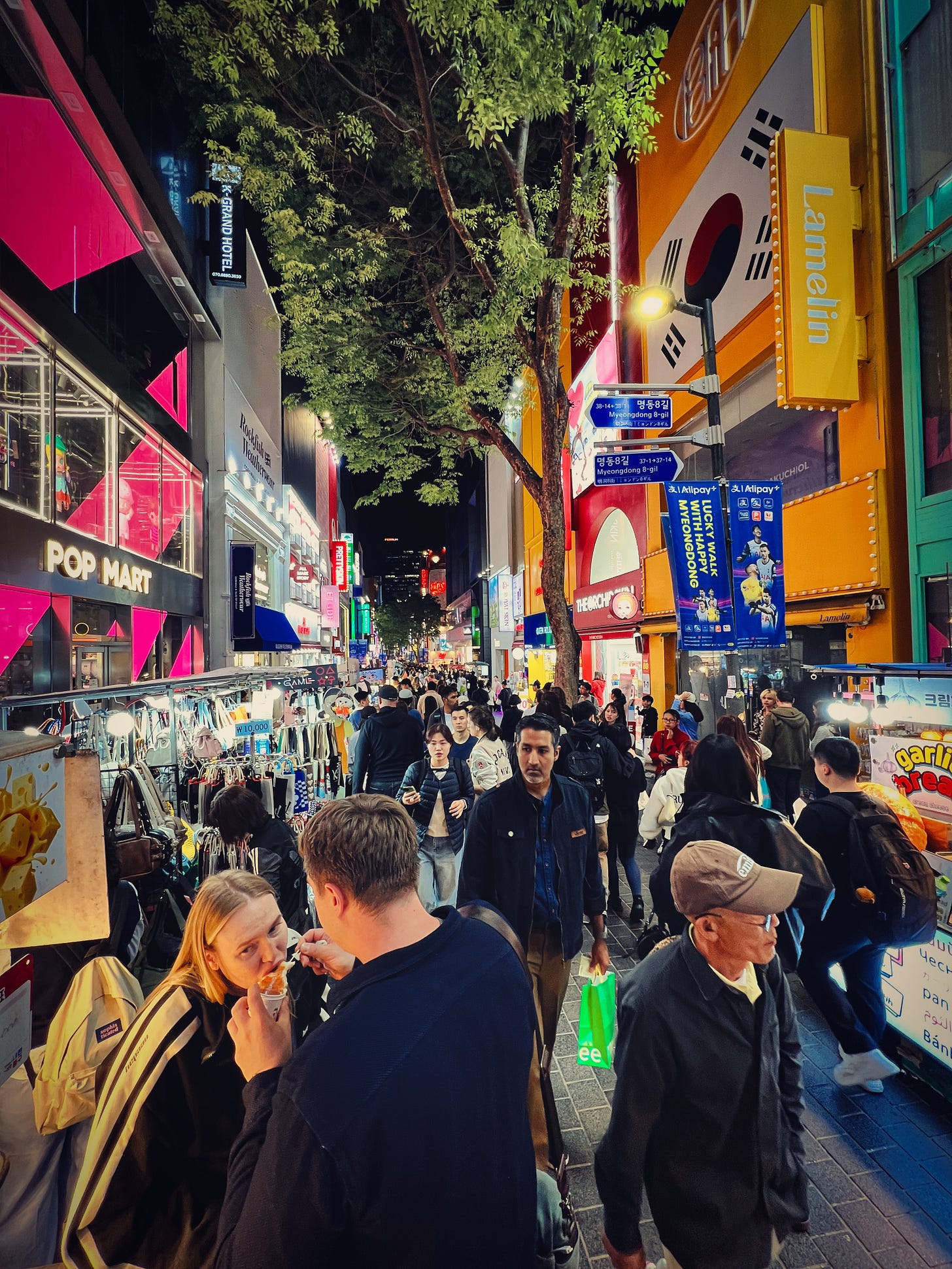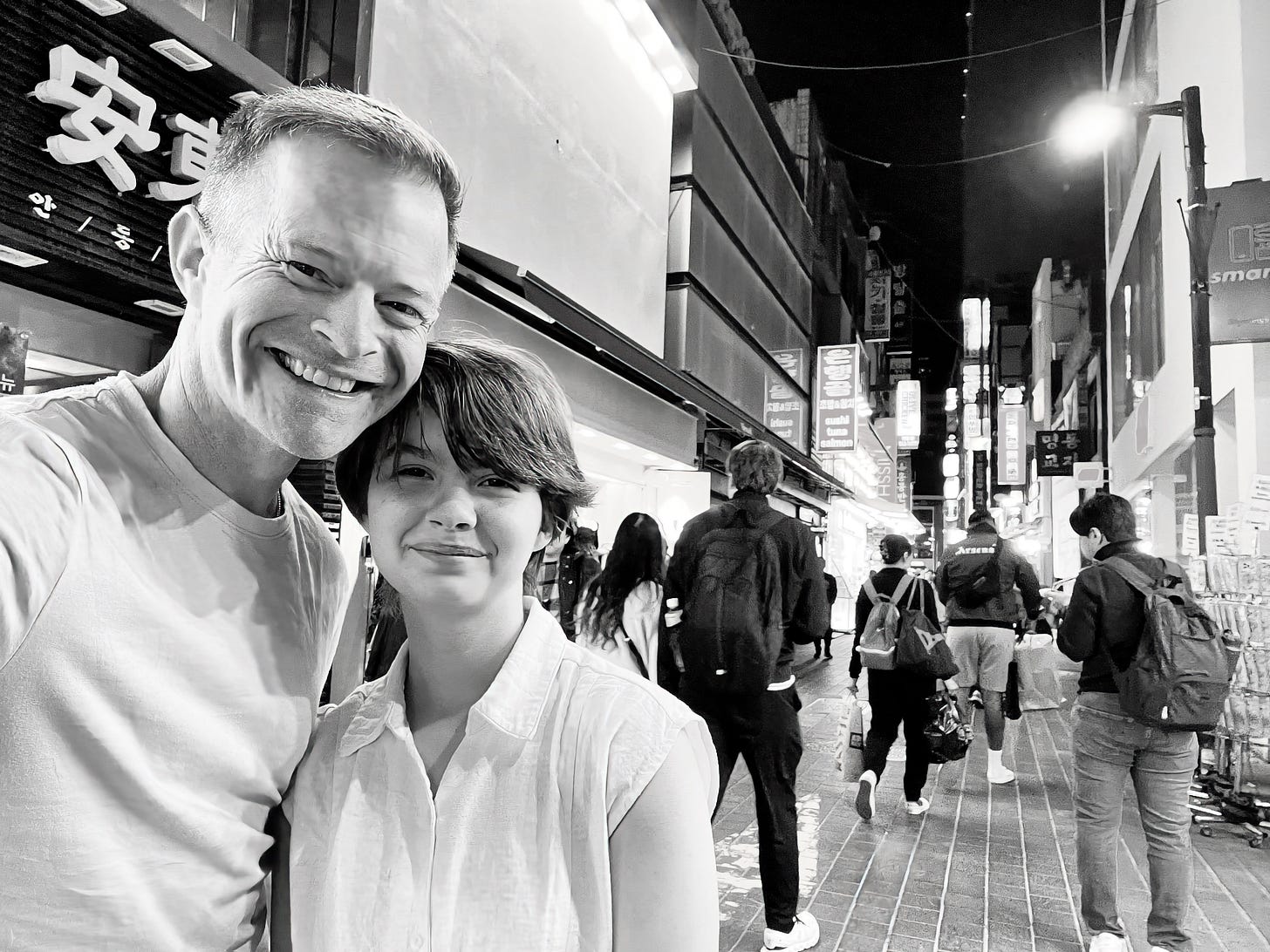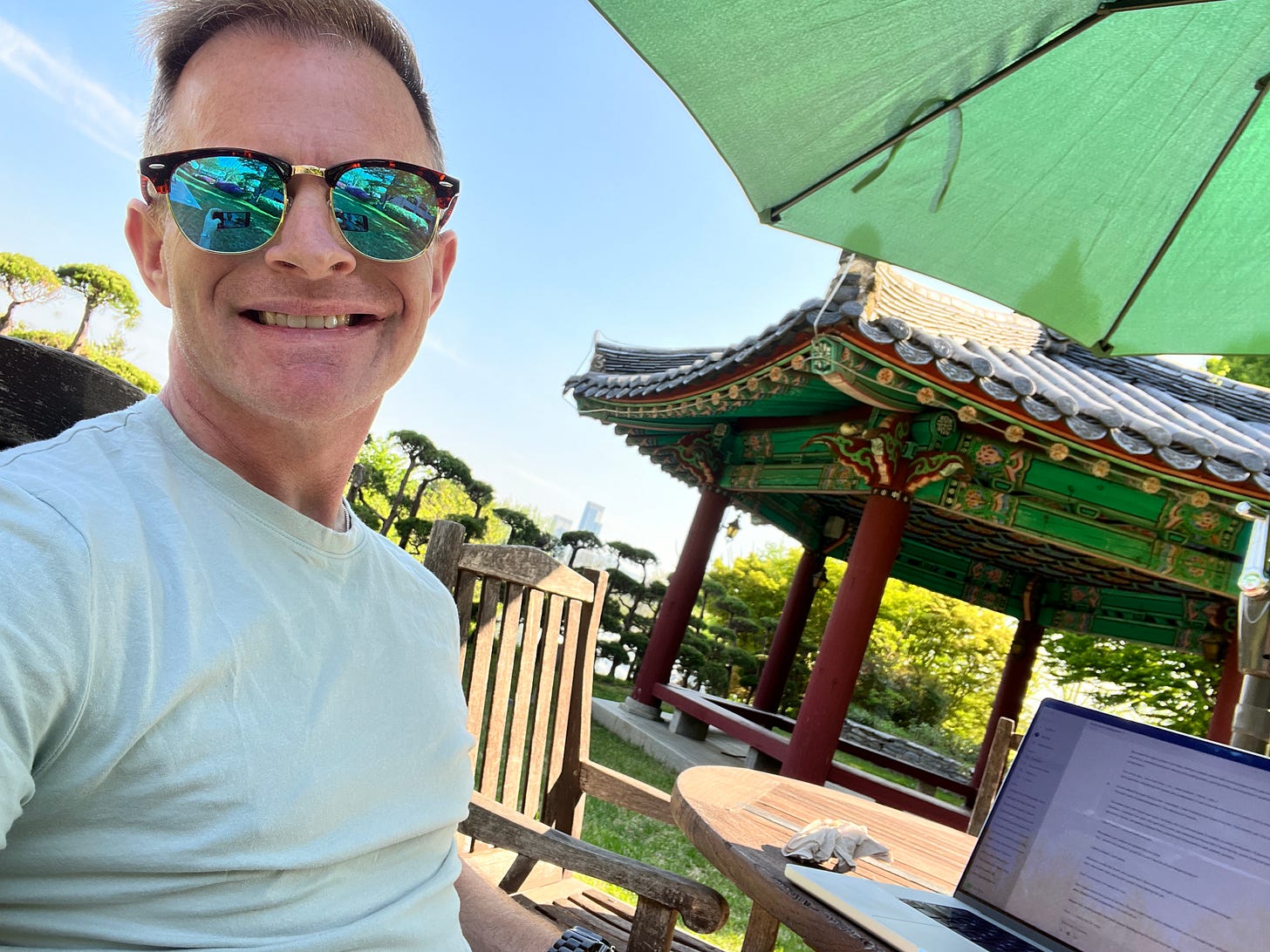About This Series
Wander, Wonder, Write is a reflective travel memoir chronicling my journey through South Korea with my 13-year-old daughter. It’s part love letter, part field journal—capturing not just where we go, but who we are becoming along the way. Through crowded markets, quiet moments, and unexpected conversations, this series explores the emotional terrain of parenting, identity, healing, and what it means to feel at home in the world. It’s a story about movement—across continents and within the heart.
Know someone who might enjoy reading this? Please share it!
Introduction
I sat on the edge of the hotel bed this morning, watching her pace the room, phone pressed to her ear, her voice bubbling with excitement. She spoke fast and full of color, relaying the day’s adventures to her mom in that unique language only 13-year-olds seem to speak fluently—half giggle, half gasp, words rising and tumbling with momentum, barely touching down before the next idea swept them away. I didn’t catch every word, but I didn’t need to. Her joy was unmistakable. Whatever else is happening in our lives—whatever tension simmers beneath the surface, whatever decisions loom—right now, she is truly living her dream. And I have the privilege of walking beside her while she does it.
As I listened to her chatter, I couldn’t help but reflect inward. About this trip. How far we’ve come. How we made it half-way around the world without planning or even a goal… other than to see what we could see when we got wherever we were going. Is this trip an escape? Am I just running away from the complexity of home? Or am I trying to prove something to myself—that I’ve healed enough, evolved enough, to pull something like this off? Or maybe this is what healing looks like: living in the in-between, giving yourself permission to laugh, to explore, even while questions still remain unanswered.
Back home, life carries on. Relationships shift, unravel, or evolve, depending on the lens through which I choose to see them. The future, at times, feels like a caged lion—angry, pacing, waiting to be released. And in my head I have constructed a fragile lamb of a dream: quiet, hopeful, delicate. I don’t know which will break free first, or what will be left standing when they meet. I know I’ll have to answer these questions eventually—explain things I’m not even sure I understand myself. But not today. Today I resist the urge to fix. I resist the pull to plan. I sit. I breathe. That’s all I can do.
I heard her tiny voice from across the room: “Good night, Mom. I love you.” Soft. Sincere. As if tethering herself back to something safe and known before setting out in this foreign land.
And then, I noticed something different…
Her hair
The Haircut and the Heart
It seems like such a small thing, but her hair has always been a battleground of identity.
Fiercely independent, she’s long resisted any offer to help style it, any suggestion that implied she needed guidance. Feedback is often met with defiance. She’s never said it outright, but I know the message: Let me be who I am, in my own way.
About six months ago, while her mother was away on business, we agreed to a trim. At the time, my daughter’s hair reached the middle of her back—thick, wavy, and prone to tangles. I suggested it might be time for a little maintenance. Nothing major. Just a few inches to keep it healthy and manageable.
We walked into the salon together. I spoke briefly with the stylist, explaining what we had discussed—a simple trim. My daughter nodded in agreement, took her place in the chair, and I stepped back into the waiting area. Twenty minutes later, she reappeared. Her hair had been chopped.
Not trimmed.
Chopped.
Gone was the shoulder-skimming wave we’d agreed upon. Her hair now hovered just above her ears, blunt, somewhere close to a bowl cut.
I masked my shock. She didn’t say a word. Her eyes flicked up at me—part embarrassment, part regret. It was clear she’d asked for this. And it was just as clear that she now wished she hadn’t. I imagine she got a little carried away with the stylist, and before she knew it, she was in over her head. What stylist allows a 13-year-old to completely change the plan without checking with the parent, I still don’t know. But I set that concern aside for the moment and focused on what mattered most—the breach of trust standing quietly in front of me.
We drove home. Ate dinner. Made small talk.
Then I broached the subject gently, trying to avoid what I imagined would have happened had I done such a thing as a child—World War III.
I’d like to talk about how we went from an inch or two trim to… what we have now.
She didn’t argue. She didn’t deflect. She simply looked down, and then the tears came.
What followed wasn’t a scolding. It wasn’t about rules or obedience. It became, instead, a quiet and vulnerable hour of honesty. I asked questions. She answered some. Others she couldn’t quite name yet. She admitted she got swept up in the moment—that the stylist had asked what she wanted, and in the excitement of being heard, she just… kept going. Snip after snip, inch after inch.
I told her I understood. I told her I wasn’t angry, just surprised. And I reminded her that trust between us is precious—earned, not assumed. That when we make agreements together, they matter. She told me she just wanted to feel in control of something. That she was tired of other people making decisions about her body, her appearance. I listened. I affirmed. And what could have easily spiraled into resentment or shame instead became a moment of unexpected closeness. We walked away that evening not just with the evidence of a haircut gone sideways, but with a deeper understanding of each other.
She nodded. She said she was sorry. And I told her it was okay.
That she was okay.
And just like that, what could’ve been a meltdown became a milestone. Not because of a haircut, but because of what we both learned about respect, autonomy, and staying connected even in the hard moments.
She’s been growing it back ever since.
Since then, I’ve occasionally, gently, offered suggestions—ways to style her hair that might frame her face or highlight her natural waves. Most of the time, these are met with the classic teen arsenal: eye rolls, sarcastic replies, or a dismissive flick of the wrist. I’ve learned to hold those suggestions loosely. I want to respect her independence while still offering the guidance and care that I believe are part of my role as her father.
Which is why today caught me completely off guard.
Without announcement, without commentary, she styled her hair the exact way I had once suggested—months ago, during one of those eye-roll-inducing conversations. It looked lovely. More importantly, it looked like her. A version of her she had chosen, on her own terms.
I didn’t say a word. Didn’t point it out. Didn’t celebrate it. I just noticed. She did it herself. In her own time.
Maybe things are changing.
Not just her hair.
Myeong-Dong: Where the Night Comes Alive
Tonight was all about the night market—the classic soul of Seoul, pulsing through the city’s veins in the form of bass-thumping music, kaleidoscopic lights, and the rich, sizzling perfume of street food. This city doesn’t wind down when the sun sets—it wakes up.
As twilight slipped into night, Myeong-dong lit up like a carnival. Throngs of people spilled into the narrow streets—locals, tourists, couples on dates, teenagers in matching outfits, ajummas with shopping carts, toddlers in strollers sucking on rice cakes the size of their heads. Music boomed from every storefront, competing for attention: K-pop blaring at one corner, jazz guitar weaving from a café window, indie ballads crooning softly from a vendor’s Bluetooth speaker. It was chaos—and perfect harmony.
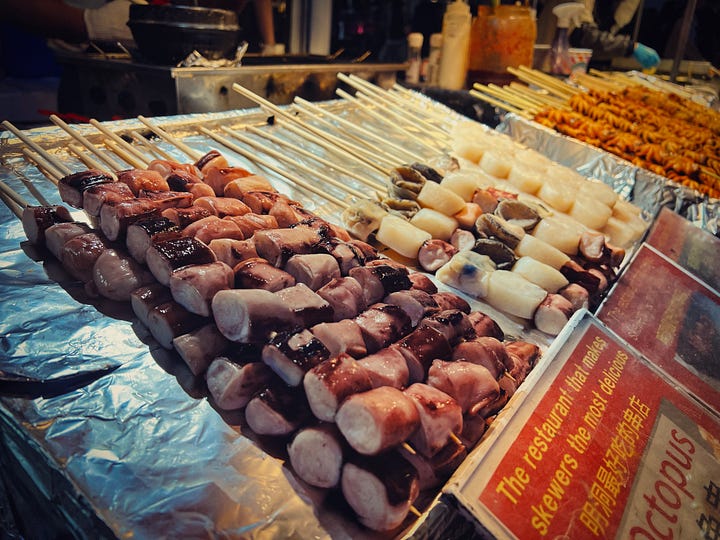


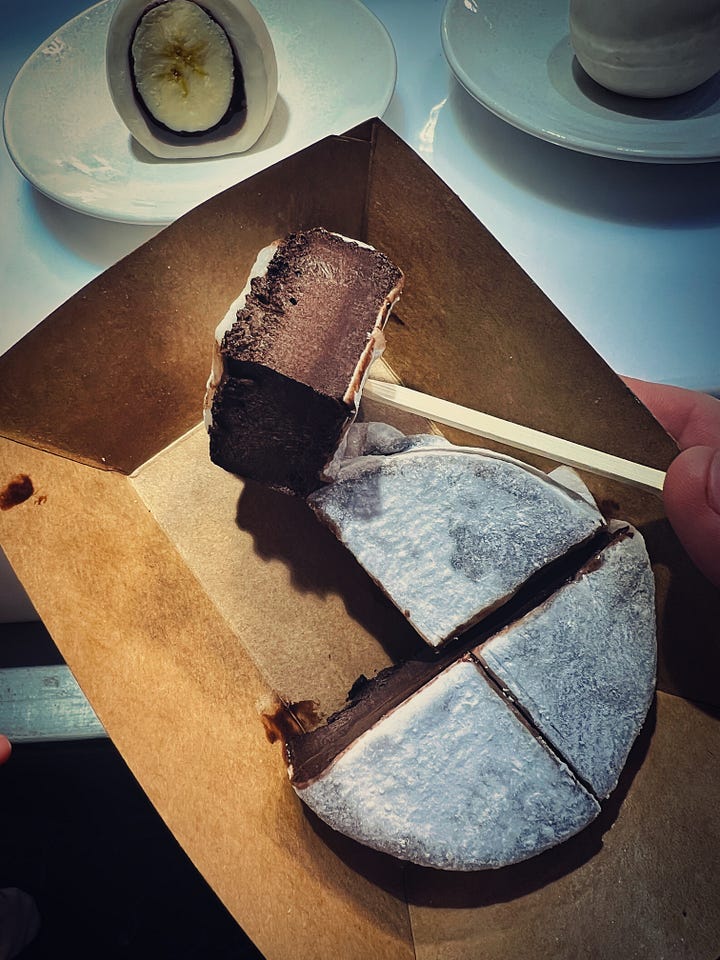
The air was thick with the smell of frying oil, sweet batter, charred meat, and brown sugar melting over open flames. Steam curled up from skewers of spicy tteokbokki, glistening in red sauce. Cotton candy spun into pastel mountains. Hotteok sizzled on flat griddles, their syrupy centers bubbling under the surface. We passed stands offering fish-shaped waffles stuffed with red bean paste, and booths handing out glowing drinks in lightbulb-shaped bottles—novelty with a straw.
Everywhere, signs blinked in neon Hangul, while shopkeepers barked out their deals in a mix of Korean, English, Mandarin, and hand gestures. LED face masks, color-changing lipsticks, and snail-slime face creams called out from beauty shops as customers elbowed their way toward sales.
My daughter’s eyes sparkled with wonder as she darted from one booth to another, her voice bubbling with excitement. I followed, smiling at the magic of it all. Beneath the glitz and noise, there was something grounding about it too—an unspoken reminder that no matter where we come from, we are all drawn to color, to sound, to warmth, to food. To life.
This place was alive. And so were we.


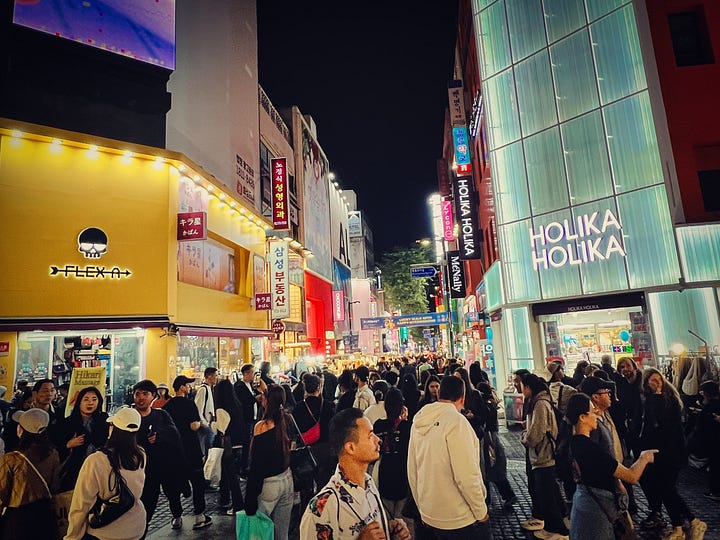
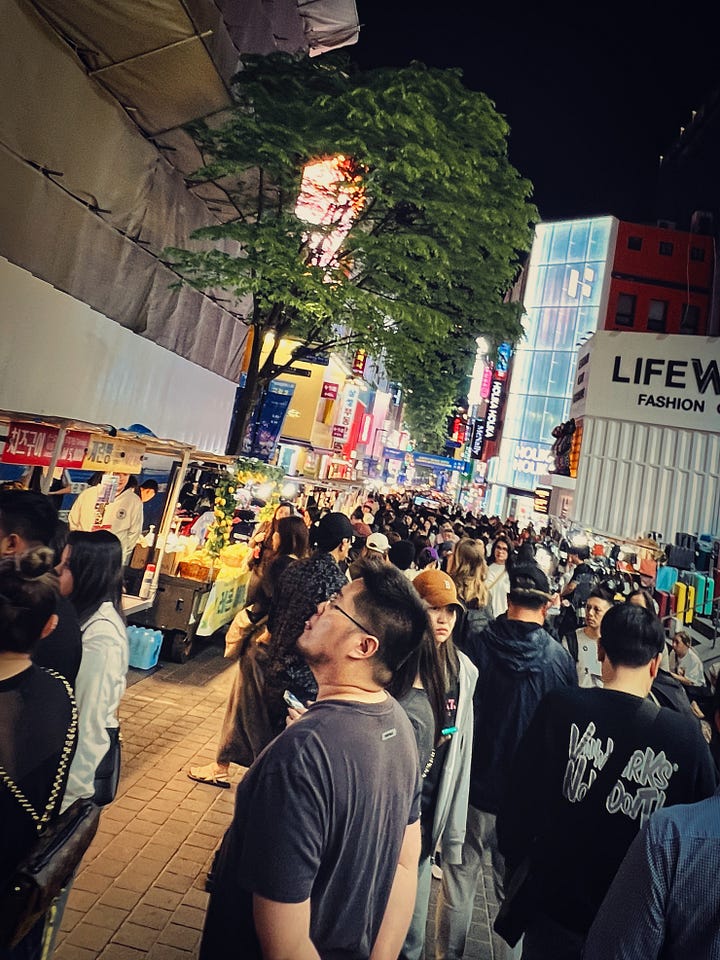
Walking through the humming streets of Seoul, our conversations danced from K-pop boy bands to collectivist vs. individualist cultures to whether kimchi should be classified as a vegetable or a religion. At some point, the tone shifted.
You know, I don’t think I have many real friends, she said, pausing to watch a group of teens pose outside the LINE Friends store. Like… people who really get me.
She’s said this before—always with a certain calm, like she’s not complaining, just naming something quietly true. But it cuts every time. She didn’t sound sad. Just thoughtful. Reflective. Still, as I looked at her—thirteen going on thirty, asking questions that carry weight and complexity—I felt that familiar ache rise in my chest.
I know that feeling. I’ve carried it for most of my life.
When your thoughts outpace your peers, when your emotions run deeper than most people are comfortable exploring, when your passions diverge from the expected—you can start to feel like an outlier in every room. It’s not about being smart. It’s about living with a depth and intensity that doesn’t match your surroundings. The world, somehow, feels too loud and too shallow all at once.
Kids like my daughter—those who grow unevenly on the inside, whose emotional fluency and cognitive insight outpace the age printed on their school IDs—often face a quiet, persistent kind of loneliness. One that doesn’t have a name. They crave connection but are drawn to ideas, questions, and feelings their peers haven’t yet discovered. They can laugh at memes and blend in when needed—but it’s a mask. A part-time role. The real self, the one filled with wonder and a constant stream of why, usually stays hidden.
But nothing softens the first realization that you’re just… different. Not better. Not worse. Just… significantly different, in the statistical sense. Which is really just a nerdy way of saying: rare enough to notice, real enough to feel.
Neon signs blinked in every direction, casting candy-colored reflections across the slick pavement. Music spilled from every alley—K-pop, jazz, American hip hop—layered into a chaotic harmony that somehow worked. Street vendors shouted in three languages, beckoning us with sizzling meats, skewered rice cakes, and hot, golden pancakes oozing brown sugar. The scent of garlic, grilled squid, and sweet batter swirled together, intoxicating and impossible to separate.
People moved shoulder to shoulder in every direction, a living current of color and noise. Some wore LED signs advertising massages, cat cafés, and other wonderfully strange offerings unique to Korea—selfie studios, skincare pop-ups, claw machine arcades filled with plush toys and pastel lights. One man in a full Pikachu suit spun a glowing baton while dancing to trot music, entirely unbothered by the stares.
We moved with the crowd, no longer navigating it—just immersed in it. Everything felt alive. Alive in a way that made it hard to remember the ache I’d been carrying moments before. Alive in a way that made us feel, briefly, like we belonged to something vast and electric.
This isn’t something I talk about often—the underlying reasons I often feel so alone. This is mostly because few people truly understand, and many tend to dismiss what they don’t relate to, so what’s the point of trying to explain? The truth is, I was tested as a kid. Those scores didn’t mean much to me at the time. They didn’t open doors or make life any easier for me—they just came with the weight of expectation or the sting of separation. So, I learned to keep that part of me quiet. I hid the intensity. I got good at fitting in.
I became a performance, instead of a person.
But even when I dropped the act and joined the human race as a more authentic version of myself, nothing much changed. Because, as Jung put it, “Loneliness does not come from having no people around you, but from being unable to communicate the things that seem important to you.” Loneliness doesn’t stem from solitude—it stems from disconnection. From the inability to share your inner life and be met there. And if you’re wired differently from most—especially while you’re a teen still figuring out who you are—then yeah… it can be really hard to feel connected.
I reached for her hand in the crowd.
Yeah, I said. I’ve felt that way too… For most of my life.
She didn’t say anything. But she didn’t let go.
We talked about what it means to feel known—really known. How rare that is. How beautiful. We talked about the difference between people who like your company and people who understand your insides.
She said it often feels like she’s speaking another language around kids her age.
Everything is surface. It’s like no one wants to think deeply about anything, you know?
There it was—the unnameable ache of the intense mind. Of the sensitive soul.
I told her I’ve known that ache too. That feeling of being wired for a kind of depth that isn’t always welcomed or mirrored. I told her that some of us spend our lives searching for those rare conversations that feel like resonance instead of static. I didn’t tell her that the ache never fully goes away.
I didn’t tell her I don’t really have a solution.
And yet, somehow, we moved through the crowd like we belonged—singing out loud, dancing in the streets, laughing until the night blurred around us. We heard French being spoken and struck up instant friendships. She ordered food for us in perfect Korean from a street cart blasting BTS. I raised my eyebrows in surprise, waiting for her to celebrate like she did the night before. She just shrugged and bit into her mandu.
And I thought—maybe this is the answer. Travel. Not a solution, but a balm.
We kept walking—shoulder to shoulder, weaving through the crowd, sharing stories and half-formed thoughts about sci-fi plots, psychological theories, and whether a time-traveling version of Stray Kids could save the world. We laughed at our own nerdiness, unbothered by the fact that no one around us knew what we were talking about.
And yet… we belonged.
Not because we fit in, but because we fit together.
Seoul shimmered around us—alive, bright, strange, and beautiful. We didn’t need to be understood by everyone. We had each other. And in that moment, under neon skies and surrounded by strangers, we weren’t just passing through.
We were home.
About the Author
ES Vorm, PhD is a writer, father, and recovering overachiever who once built a life chasing credentials and now finds greater meaning in street food, quiet conversations, and homeschooling his daughter. A former scientist, aviator, and warfighter, he now writes about healing, complexity, and the beauty of being fully human. His work explores the intersections of intensity, recovery, and connection, often through the lens of parenting and personal transformation. He believes the best stories are the ones we live, and the bravest thing we can do is tell them honestly.





